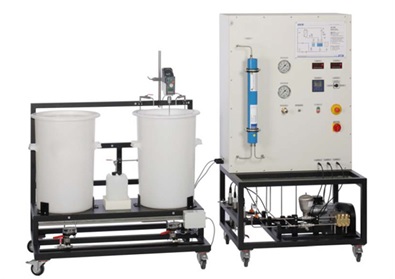WT-13 REVERSE OSMOSIS
Description
This trainer has been developed in cooperation with the Institute for Thermal Process Engineering at the TU Hamburg-Harburg. A solution of NaCl in a defined concentration is mixed in a tank complete with a stirring machine. A pump delivers the solution to the spiral wound membrane module. The pump generates the necessary pressure for separation. The spiral wound membrane module consists of multiple membrane envelopes. A membrane envelope is made up of two membranes with aporous spacer between them. The membrane envelope is sealed on three sides and on its fourth, open, side is connected to the perforated permeate collecting tube. There are other spacers between the envelopes to ensure axial flow of the salt solution. The spacers together with the membrane envelopes are wound spirally around the permeate collecting tube. The salt solution arrives at the front face of the module and flows axially between the envelopes. The semi-permeable membrane is permeable to water (permeate) but not to dissolved NaCl. The applied pressure forces the water through the membrane into the envelopes. In the envelopes the water flows spirally towards the permeate collecting tube and exits the module in an axial direction. As a result of the water being removed, the solution is concentrated as it travels through the module. It exits the module as retentate and is returned to the raw water tank. The permeate is collected in a separate tank. Another tank containing distilled water is provided to flush through the spiral wound membrane module. The pressure and flow rate can be adjusted by valves. In order to check the success of the separation, salt concentrations in the raw water, retentate and permeate are recorded by measuring the respective conductivity values. The well-structured instructional material sets out the fundamentals and provides a step-by-step guide through the experiments.
EXPERIMENTS
– Assembly, cleaning and conservation of membrane modules
– Fundamental principle of reverse osmosis
– permeate flow rate and retention dependent on
* Pressure
* Salt concentration in raw water
* Yield
– Determination of diffusion coefficients
SPECIFICATION
- Removal of solvent from a salt solution using reverse osmosis
- Polyamide spiral wound membrane module
- Piston pump with pulsation damper for pressure generation
- Overflow valve to adjust the pressure upstream of the membrane module
- Valve to adjust the retentate flow rate
- Raw water tank with stirring machine to prepare a salt solution
- Tank for distilled water to flush through the spiral wound membrane module
- Tank to collect the permeate
- Safety cutout to protect the pump against dry running

TECHNICAL DATA
| Product & Code | Reverse Osmosis & WT-13 |
| Spiral wound membrane module | – Active area: 1,2m² , raw water flow rate: max. 23L/min , length: approx. 500mm , diameter: approx. 60mm |
| Piston pump | – max. Flow rate: approx. 425L/h – max. head: approx. 700m |
| Stirring machine | – power consumption , speed: 30…1000rpm |
| Tanks | – raw water (salt solution): approx. 110L
– distilled water: approx. 110L , permeate: approx. 5L |
| Measuring ranges | – retentate flow rate: 0,2…6,0L/min , permeate flow rate: 0,05…1,8L/min , temperature: 3x 0…50°C , pressure: 2x 0…120bar , conductivity: 0…200mS/cm |
| Weight | approx. 250kg |
| Connections | 230V, 50/60Hz, 1 phase ,Drain required |
ABOUT OUR COMPANY
WE MANUFACTURERS WIDE RANGE OF PRODUCTS LIKE HEAT TRANSFER LAB EQUIPMENT, HYDRAULIC BENCH, HYDRAULIC MACHINES LAB EQUIPMENT, ETC. WE MANUFACTURE THESE PRODUCTS AS PER THE LATEST MARKET TRENDS AND DELIVER THESE AT USERS’ PREMISES WITHIN THE SCHEDULED TIME FRAME.
Contact Us
Have questions, comments or just want to say hello:
- mass_international99@yahoo.co.in
- 92156-00789 , 9215900789, 9812225689, 9812200689
- Regd. Office Works:
Plot No. 459, Sector – 2, Phase – 1, Industrial Estate Growth Centre,HSIIDC, Saha – 133104
GSTIN. No. 06ADYPK5042P1ZS
Website Design By | Design: Fame Digital Worlds by Fame Digital Worlds
